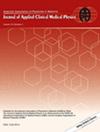Assessing HyperSight iterative CBCT for dose calculation in online adaptive radiotherapy for pelvis and breast patients compared to synthetic CT
Abstract
Purpose/objectives
Recent technological advancements have increased efficiency for clinical deliverability of online-adaptive-radiotherapy (oART). Previous cone-beam-computed-tomography (CBCT) generations lacked the ability to provide reliable Hounsfield-units (HU), thus requiring oART workflows to rely on synthetic-CT (sCT) images derived through deformable-image-registration (DIR) between the planning CT (pCT) and the daily CBCT. These sCTs are prone to errors stemming from DIR, potentially contributing to dosimetric errors. This study aims to evaluate the capability of direct dose calculation using a novel CBCT platform, HyperSight (Varian-Medical-Systems), as an alternative for sCT.
Methods/materials
To validate the HyperSight iterative CBCT (HS-iCBCT) HU accuracy, 125 kV and 140 kV HS-iCBCT calibration curves were benchmarked against a pCT calibration curve. To determine the clinical impact of HS-iCBCT compared to sCT, daily adaptive sessions from 47 oART fractions from 10 patients were analyzed. For these patients, HS-iCBCT was acquired for daily adaption, and sCT was generated as part of the standard adaptive workflow. After daily adaption, dose was recalculated directly using the HS-iCBCT, and the HS-iCBCT and sCT dose distributions were compared by γ-index and dose-volume-histogram (DVH) analysis.
Results
The mean HU differences of pCT minus HS-iCBCT (140/125 kV) were −40.97/−57.79, 9.86/21.74, and 87.22/158.20 for lung, water, and bone. In the patient cohort, the median gamma passing rates between HS-iCBCT and sCT-based dose calculations for 3%/2 mm and 1%/1 mm were 99.57 and 96.45% with 10% threshold, and 99.92% and 86.15% with 80% threshold. Dosimetric deviations in high dose regions were concentrated in areas with larger deformation, that is, surface change and variable bladder/bowel filling. The median (min-max) D98%/V100% absolute deviations were 0.3(0.0–1.6)/0.0(0.0–13.7) and 0.4(0.0–1.4)/0.5(0.0–17.5) for CTVs and PTVs.
Conclusions
The HS-iCBCT platform with iterative reconstruction provides dose calculation comparable to sCT for pelvis and breast patients. However, acceptable, yet noticeable, dose discrepancies between HS-iCBCT and sCT exist, particularly in high-dose regions. Further investigations are needed to benchmark these methods against ground truth measurements.


 求助内容:
求助内容: 应助结果提醒方式:
应助结果提醒方式:


